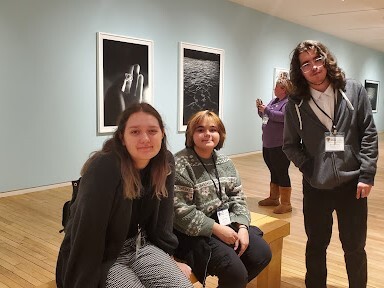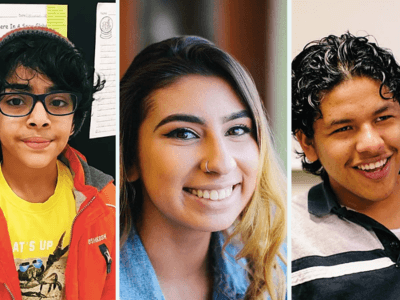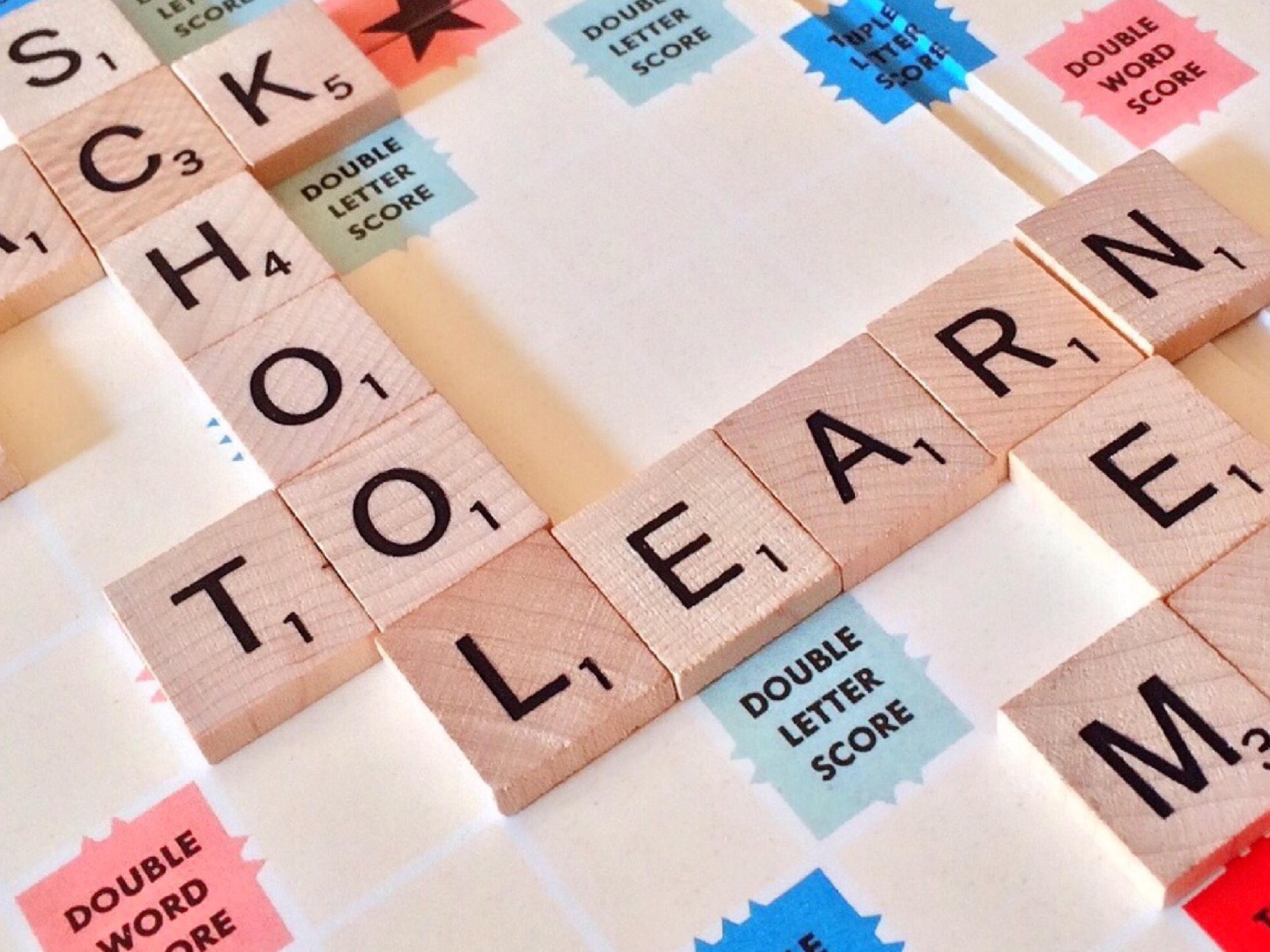Reimagining Assessment
MyWays #3: Assessment Design as Integrated as Your Definition of Student Success
Topics
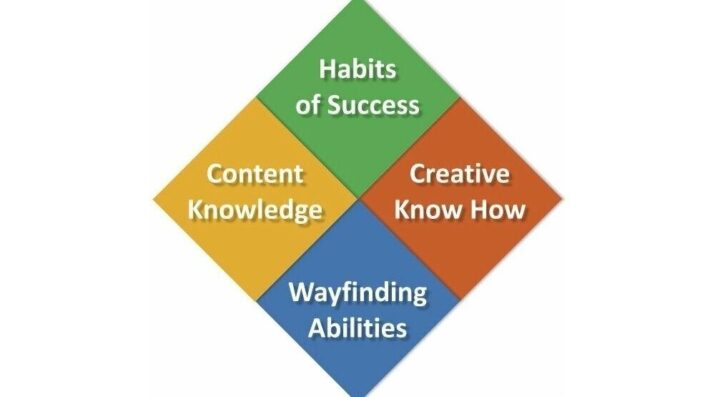
Educators are rethinking the purposes, forms, and nature of assessment. Beyond testing mastery of traditional content knowledge—an essential task, but not nearly sufficient—educators are designing assessment for learning as an integral part of the learning process.
Practitioner's Guide to Next Gen Learning
Answering Next Gen Learning’s Three Big Questions - Part 3
Editor's Note: Updated materials now available! Visit myways.nextgenlearning.org for the most up-to-date information and tools from the NGLC MyWays project.
This blog post on MyWays provides tools for you to use in connection with the third of these three Big Questions:
- How well are we defining and articulating what success looks like for students attending our school?
- How well does our design for learning and the organization of our school directly support students' attainment of our richer, deeper definition of success?
- How do we gauge students' progress in developing those competencies? And: How can we measure and articulate our school’s overall performance, beyond proficiency in ELA and math?
For tools to answer the first and second questions, see part 1 and part 2 of the series.
Whether you are already engaged in designing or implementing next gen learning, or considering it (in part enabled by the new Every Student Succeeds Act), we hope you will use the MyWays tools as “critical-friend” analytical lenses to examine the depth and clarity of your answers to the three Big Questions of Next Gen Learning. This third blog introduces the research and framework we have produced to help you and your colleagues address the third question, which in many ways, over the past couple of decades, has represented the tail that has wagged the dog.
Exercise 3: Assessment Design as Integrated as Your Definition of Student Success
Assessment design is what keeps us all awake at night, bouncing between excitement over tremendously promising new possibilities and… well... terror. Terror born from concern that we are inadvertently helping to create a monster.
The MyWays competencies provide a rich, distilled and synthesized composite of the more than two dozen major “richer/deeper” frameworks we were able to identify. We are convinced that this set of twenty competencies, organized in four arenas—Content Knowledge, Creative Know How, Habits of Success, Wayfinding—reflects a comprehensive and sufficiently nuanced answer to the question, What should today’s high school graduate know and be able to do, in order to succeed in college (or other postsecondary education), career, and civic and personal life?
But the competencies do not represent a checklist with component parts that should drive curriculum, pedagogy, scheduling, and assessment. The whole competency set is crucially important for school leaders, teachers, and (we would argue) students to hold and use as a North Star. The temptation to use them, in classic standards-based reform methodology, as definers of the assessments that in turn would shape the learning experiences of students, would almost inevitably result in the “atomizing” of the skills and in unintended consequences as shown in this fictional schemata:
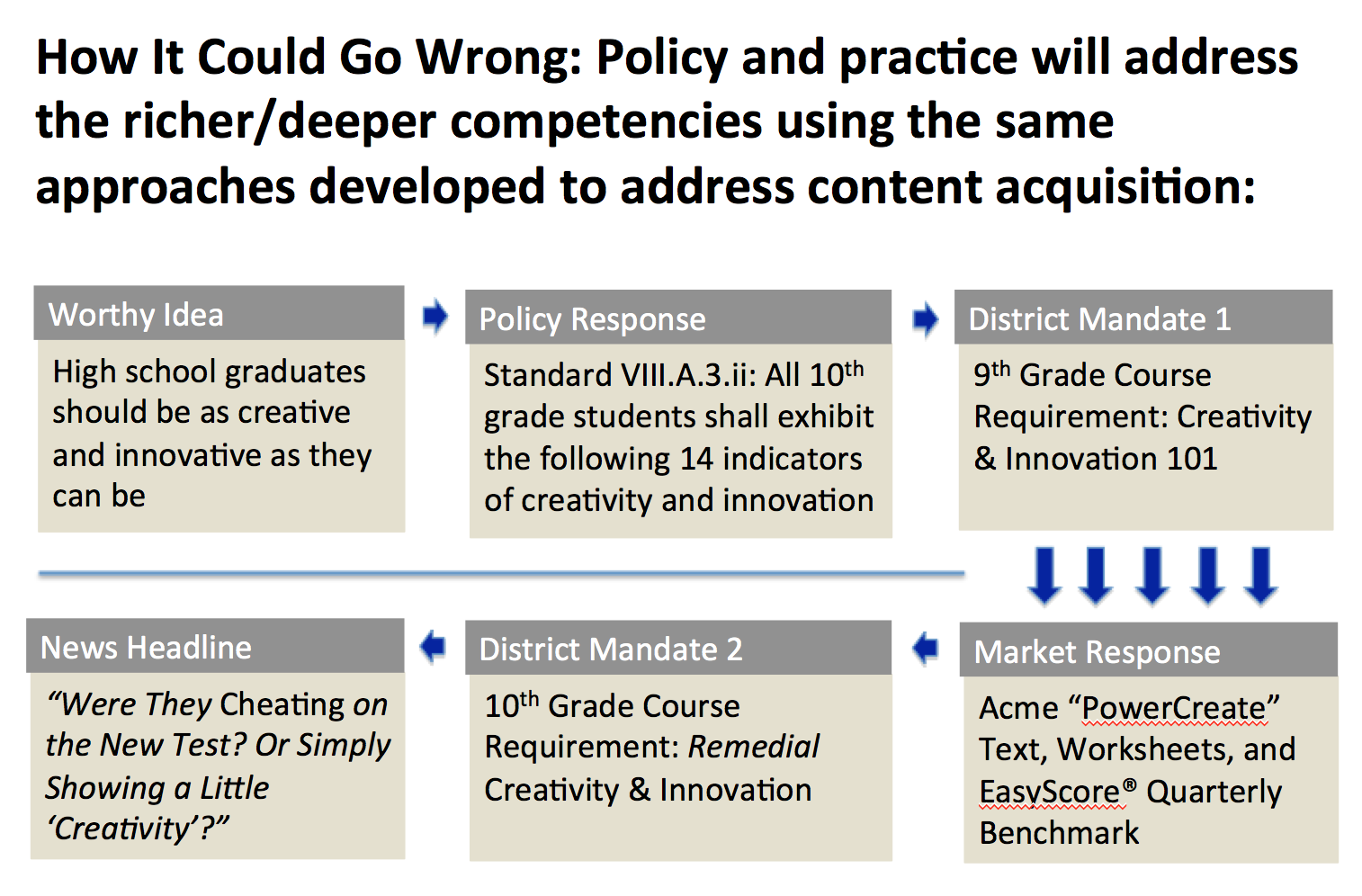
The truth is that our understanding of how to assess for this broader, deeper, richer set of competencies is in its infancy. What we do know is how much impact assessment design can have on pedagogy and students’ learning experience, especially when it is driven by accountability requirements. The first era of standards-based reform was shaped in large part by what we knew how to assess with any degree of confidence: math and ELA content acquisition. So, much of American classroom practice rolled toward drilling and test preparation. It is honestly a bit frightening to imagine what could happen if the much harder-to-assess competencies in Creative Know How, Habits of Success, and Wayfinding were to be “promoted” in the same way.
Okay: enough with the scary side. The extraordinary-opportunity side of this equation is just as compelling, and leads us to the two MyWays exercises designed to help you advance your own approach to assessment.
The Basis for the Assessment Design Exercises
As is explained in far greater detail in the Next Gen Assessment overview, we have developed three constructs to prod your leadership team’s thinking on assessment design. The first construct, seen below, illustrates two major shifts in assessment design that are already lifting off the ground and that encompass a good deal of the re-imagining of the role of assessment that next gen, personalized learning models require.
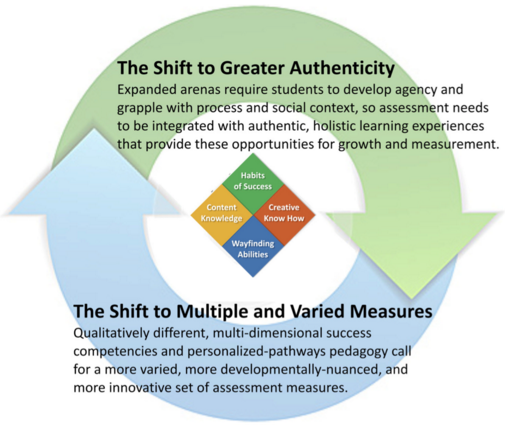
These two major shifts are catalyzing a move, already underway in many and perhaps most NGLC grantee schools, toward the design and implementation of the second construct, a multi-modal range of assessments, as seen below:
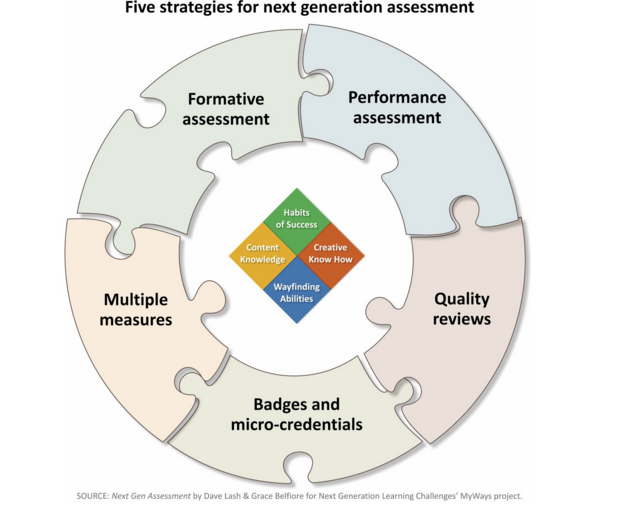
The five assessment types are described in the Next Gen Assessment overview and examples are provided for each one. The discussion hinges on the recognition that students develop multiple competencies simultaneously. In a richly designed project crossing several traditional curricular boundaries, students may be developing competencies across three or four of the MyWays arenas—Content Knowledge, Creative Know How, Habits of Success, and Wayfinding. The task of assessment within such a learning model is to surface areas of solid progress and others of concerningly insufficient progress while allowing the learning to proceed in a holistic, integrated way—what we referred to in the last post on MyWays Learning Design as whole game learning.
This matching of learning design and assessment design led to the third construct we’ve created for your use: a visual way to “plot” your current assessments, using the field of learning we introduced in the Whole Game Learning overview.
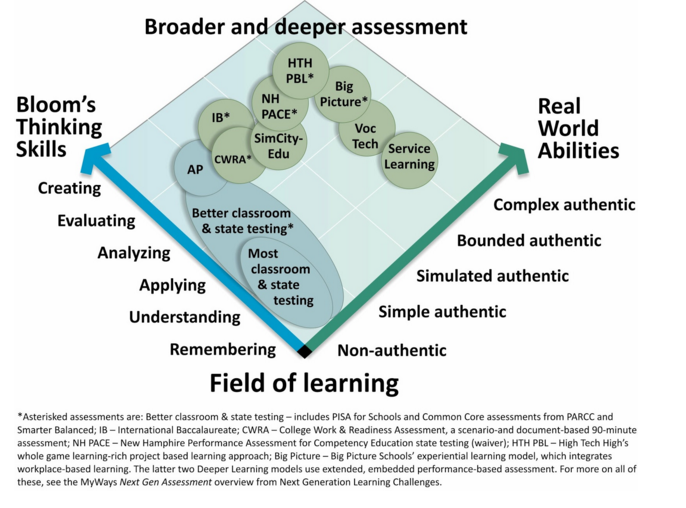
Most of the tests that states have used for accountability purposes over the past 15 years produce the equivalent, in terms of responding to classroom practice and student experience, of short bunts down the third-base line. Better tests move further out that left-field axis of Bloom’s Thinking Skills, but fail to move away from that line, out of non-authentic, traditional on-demand test design toward the more authentic forms of assessment that lie further out the Real World Abilities axis—the first base line.
Where do your current assessment strategies tend to lie? How well do they match the plotting of the learning experiences you may have done through the use of the MyWays Learning Design tools? See the comprehensive learning design version of this field of learning graphic, below.
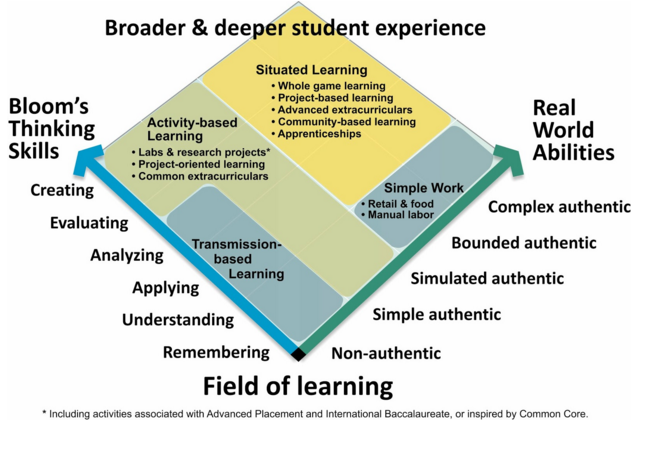
The Tools for the Assessment Design Exercises
In the MyWays Beta Toolbox, you will find the MyWays Three-Big-Questions Exercise Set. Exercise 3 includes two tools designed for your use in engaging with staff, board, and others around how your school is gauging student progress towards your complete definition of student success—the third Big Question. The exercise is presented in the slide deck; in addition, there are tools provided as separate docs and the Next Gen Assessment overview. Exercise 3a: How well is your school currently employing the five strategies that support next gen assessment, overall? Use the worksheet in the Beta Toolbox, shown below, as a tool to scrutinize your school’s full set of assessment strategies and identify opportunities to fill out your approach. A caution: Individual assessments may map directly back to individual competencies in some cases, particularly in Content Knowledge. But in general, educators should resist the temptation to tie all of the competencies to specific assessments. Instead, we encourage you to develop an understanding of when, where, and how your range of assessment strategies might pick up signals of either progress or a concerning level of stasis in any student’s development of the competencies—particularly in Creative Know How and Habits of Success. The worksheet tool provided here should help you engage your staff in understanding which competencies surface through your current set of assessment strategies and which ones need more deliberate attention.
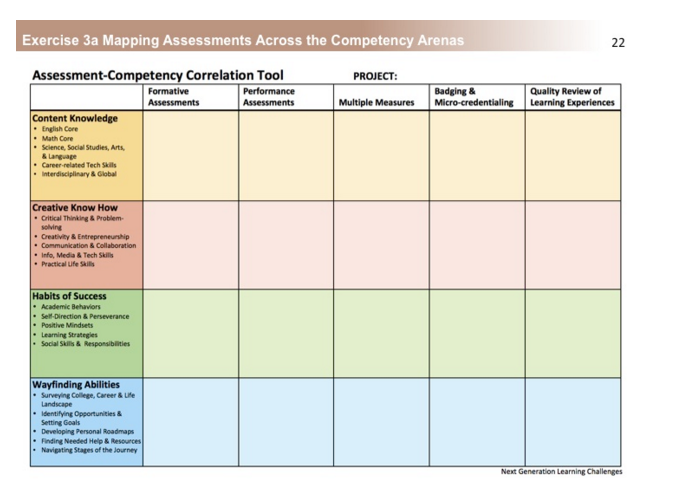
Exercise 3b: How well is your school using elements of the five strategies to assess student progress within your learning projects? This exercise helps you apply the five strategies to your design for a specific project or lesson unit. We are not suggesting that every project needs to incorporate all five strategies, but a richly designed, fully-built project (like the High Tech High Mayan Community project we use as an example) almost certainly would incorporate multiple strategies. You may use the assessment strategy analysis tool to assist with this exercise.
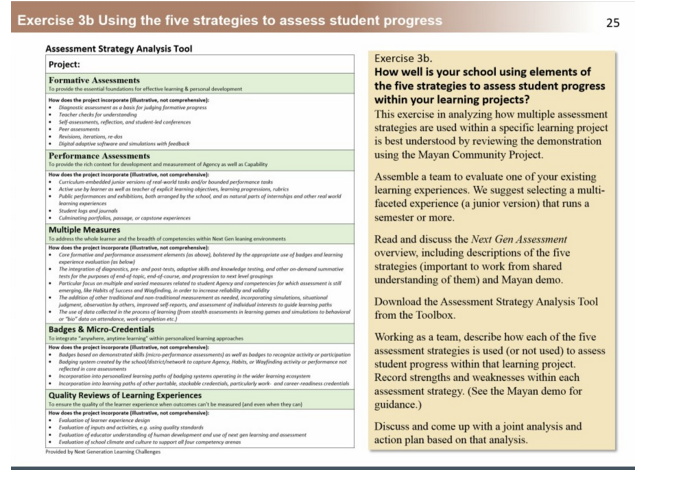
Resources
MyWays Beta Toolbox - Visit this webpage for the full set of beta-version MyWays tools and resources. These tools should help you assess your strategies to measure student growth across the MyWays competencies. A refined and more complete toolset is coming soon.
The other challenge posed in our third “Big Question,” regarding schools’ strategies in measuring and articulating schoolwide performance on the richer/deeper success definition, is the focus of a new NGLC project funded by the Overdeck Foundation. The 6-8 month research project will scan NGLC grantees’ various strategies and synthesize the results, which will be published this spring.


